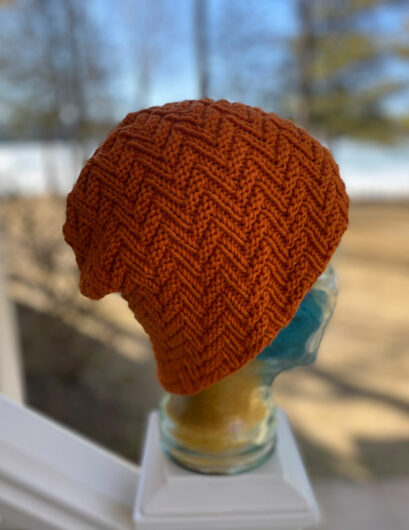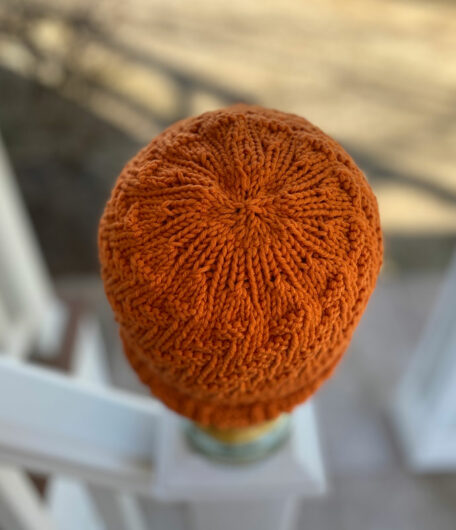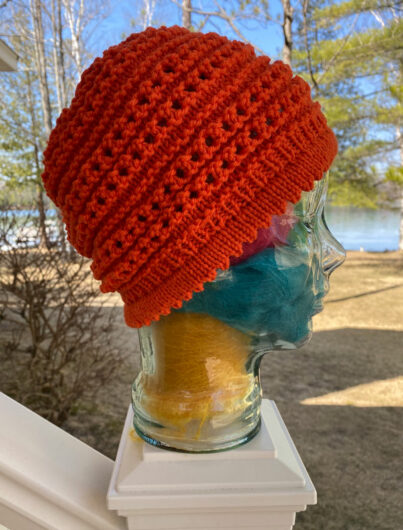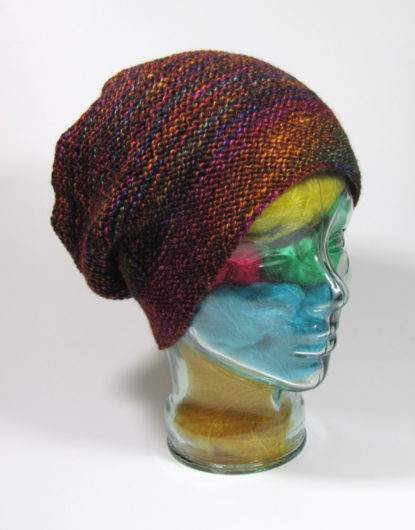Late last year I found my fade. Such a beautiful shawl, in seven coordinating (and expensive) skeins of fingering weight.

Having invested in all that beautiful yarn, I set the task for myself to use up the remnants. What I call my Faded Ursula Sockhead Hat worked out well.

This is a total mashup, that doesn’t bear much resemblance to Wendy Ellis’s After Ursula. But it was the inspiration for my hat. I cast on the Ursula number of stitches. After 5 inches of ribbing in Madelintosh Merino Light in the “gilded” colorway, I worked 4 rounds of gilded in stockinette, followed by pairs of that shade, faded in with a second color from the shawl. I worked the fade section over 12 rounds. Then I knit 8 rounds of color 2. Next came a fade section, alternating pairs of rounds in color 3 with color 2 over 12 rounds, followed by 8 rounds of color 3. And so on. I worked almost 8 inches of stockinette, after the ribbing, and then started the decreases.

I used the decreases from Kelly McClure’s Sockhead Slouch Hat–decreasing 18 stitches every 3 rounds. So, this is a mash up of Sockhead Hat, Find your Fade and a bit of After Ursula. And I used 6 of my 7 colors from my Find Your Fade shawl.
But there was still a ton of yarn left.The remaining color with the most yardage was Malabrigo Mechita in the Sabiduria colorway. I decided to knit tincanknits light version of their much-loved “Barley.” Here’s my child-sized Barley Light.

Glasshead wanted to model it, but I didn’t want it all stretched out.
Hmm. What to do with short yardage? I decided to knit for baby feet even though I don’t presently have many babies in my world. These are Vauvan Sukka (roughly, train socks, in Finnish), knit in Alexandra’s Craft’s Diamond Lake and a bit of Bad Amy yellow-gold.

I like to make these socks in interesting and sometimes arresting color combinations.
The Train Socks story has been retold a good bit, including on my blog. The pattern is attributed on Ravelry to Kerttu Latvala, and is posted by her daughter Terttu Latvala as a free pattern. The story of Vauvan Sukka is explained by Terttu, as translated into English at Teakat Translation, where the free pattern is also available. In 1939, with World War II already underway in Europe, mother and child were evacuating.There were delays because sections of railroad track had been bombed. Terttu was an infant. An infant with no socks. While they waited, a fellow passenger unraveled yarn from her white hand-knit sweater and knit Terttu a pair of socks. To pay forward that passenger’s kindness, first Kerttu and then Terttu have gifted hundreds of pairs of these baby socks to newborns.
I gifted my pair to Cecelia, who has lots of socks but now has one more pair. A pair with a story.
With one set of warm baby feet, I sort of couldn’t stop myself.

This is Frankie Brown’s free pattern, Baby Boots. One piece, worked flat, on size one needles. That Number 2 pencil eraser (remember pencils, people used to use them to write stuff) is included to show you the tiny scale of these booties.

Totally sweet, in Hedgehog Fibers Sock, in the Truffles colorway. I don’t associate gold and rose with truffles, but maybe. And it’s wonderful yarn. These were the only booties Isaac didn’t kick off.
Emboldened, it was time for a booties and hat set for the baby I’ve not yet met. This next knit is an old favorite. I’ve knit it many times.The pattern is from Homespun, Handknit, edited by Linda Ligon. It’s a wonderful Interweave Press book published in 1988 filled with patterns for hats, scarves, socks, mittens and gloves.
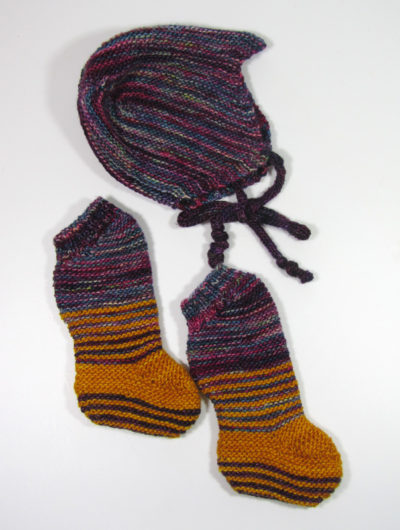
This is Bouncing Baby Set, by Jean Scorgie, minus its thumbless mittens. Babies look super cute in this head-hugger hat. And the kneesocks. Well they stay on a baby’s feet, unlike so much other stuff that we knitters knit for the wee ones’ feet.
There was still a bit more yarn left. So I knit a pair of my very own bears, Sunrise Side Bear. But instead of using worsted weight and size 5 US needles, I knit this set in fingering weight Malabrigo Mechita on size 1 needles.

These Sunrise Side Bears stand 5 and 1/2 inches tall, with a fist-to-fist span of 3 and 1/2 inches. To appreciate the scale, that mouse in the middle is holding a US penny.
They were bare. I had a little yarn left. It was enough for a vest for Boy Bear and a dress for Girl Bear. And with the last bits, came their tiny scarves.
I am feel quite proud of completing my de-stash challenge.

